Intel SSD 520 Review: Cherryville Brings Reliability to SandForce
by Anand Lal Shimpi on February 6, 2012 11:00 AM ESTRandom Read/Write Speed
The four corners of SSD performance are as follows: random read, random write, sequential read and sequential write speed. Random accesses are generally small in size, while sequential accesses tend to be larger and thus we have the four Iometer tests we use in all of our reviews.
Our first test writes 4KB in a completely random pattern over an 8GB space of the drive to simulate the sort of random access that you'd see on an OS drive (even this is more stressful than a normal desktop user would see). I perform three concurrent IOs and run the test for 3 minutes. The results reported are in average MB/s over the entire time. We use both standard pseudo randomly generated data for each write as well as fully random data to show you both the maximum and minimum performance offered by SandForce based drives in these tests. The average performance of SF drives will likely be somewhere in between the two values for each drive you see in the graphs. For an understanding of why this matters, read our original SandForce article.
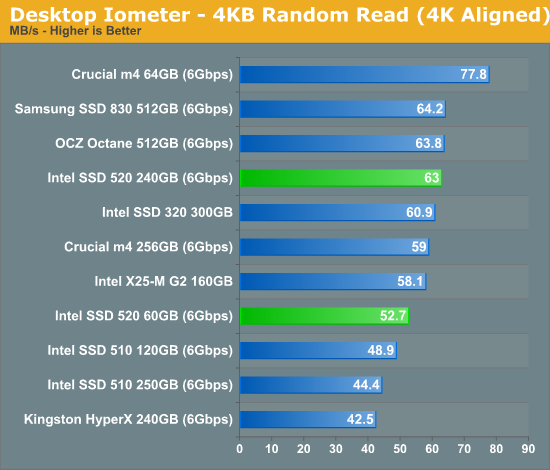
Random read performance seems to have topped out around 60MB/s for most drives and the 520 is no different here.
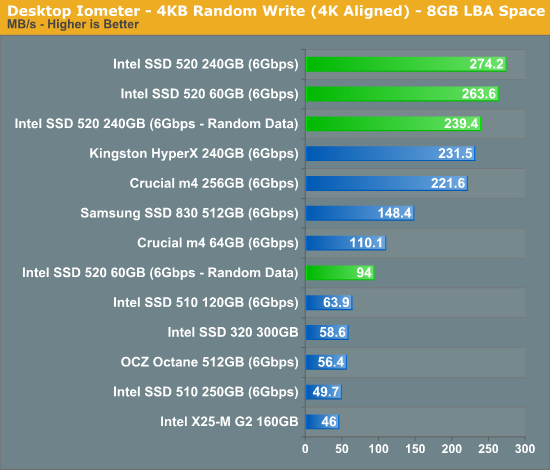
Random write performance, especially with highly compressible data sets the 520 performs beautifully - even outpacing the SF-2281 based Kingston HyperX.
Many of you have asked for random write performance at higher queue depths. What I have below is our 4KB random write test performed at a queue depth of 32 instead of 3. While the vast majority of desktop usage models experience queue depths of 0 - 5, higher depths are possible in heavy I/O (and multi-user) workloads:
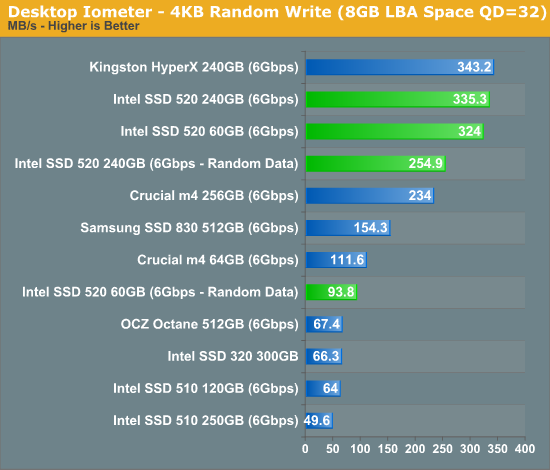
At higher queue depths the HyperX catches up to and surpassed the 520, perhaps indicating that Intel has done some work to optimize low queue depth performance on the 520 (likely what most end users will encounter).
Sequential Read/Write Speed
To measure sequential performance I ran a 1 minute long 128KB sequential test over the entire span of the drive at a queue depth of 1. The results reported are in average MB/s over the entire test length.
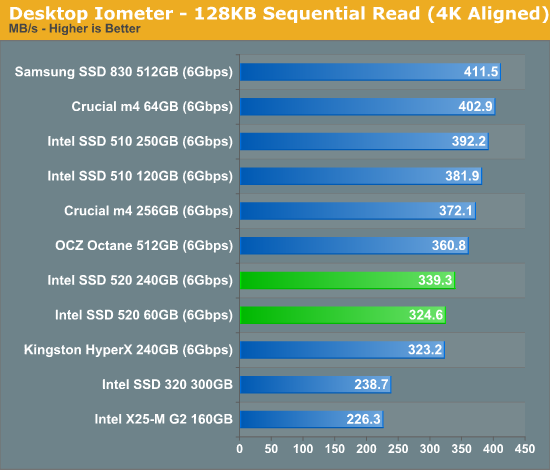
Sequential read performance is actually a bit lower than Intel's 510, but still higher than a standard SF-2281 drive.
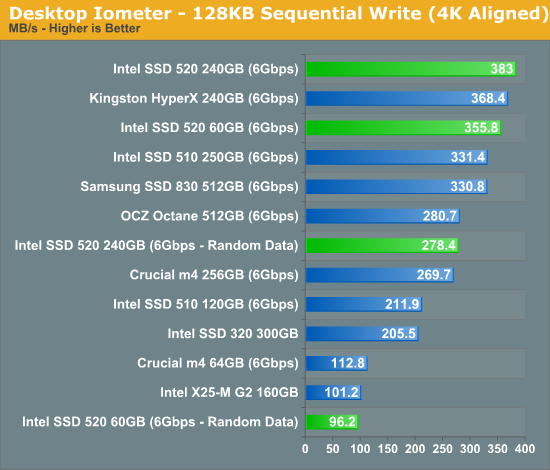
It's important to note just how close the 520's peak random write performance is to its sequential write performance. A big part of this is obviously that the SF-2281 is throwing away a lot of the data it has to write, but even if we compare incompressible 4KB random write to highly compressible 128KB sequential write we see a good ratio. The closer those two values are the more optimal the controller/firmware design is as, in theory, smaller random writes should be grouped to effectively become large sequential writes from the perspective of the NAND.










138 Comments
View All Comments
hugh2323 - Monday, February 6, 2012 - link
Some posters are missing the reason why this drive has a high premium. It is intented for the market that values reliability over price. This market considers the price of lost data to be higher than the premium of the drive. If you are a business, and a computer goes down with its data, the lost hours of productivity and cost of data loss can easily add up. Compared to paying 20% extra for the drive initially (or whatever it is), is chump change compared to that.And then there is the consumer market that doesn't have time to f*** around with blue screen of death and whose purse strings perhaps aren't so tight.
So if you don't want to pay the premium, then your not in the target market. Simple as that.
neotiger - Monday, February 6, 2012 - link
... except this SSD doesn't give you reliability.It doesn't have any capacitors, which means after a computer crash or a power outage you will lose your data.
Not exactly reliable.
eman17j - Wednesday, February 8, 2012 - link
ssd are nonvolatile memory how are you going to lose all your data?eman17j - Wednesday, February 8, 2012 - link
oops I spoke to soon I know what you mean it wouldnt have the power to finish any write operation if there was an crash or power outage thereby losing your databji - Wednesday, February 8, 2012 - link
Irrelevant. Any application can make a sync call to ensure the data is written to the flash as necessary. Any application which does not make this sync call is risking the data at multiple levels of write cache before it actually makes it to the flash, so a capacitor would reduce the window of opportunity for data loss only slightly. And if you care that much about data loss, you are using sync anyway at that point of the application.eman17j - Wednesday, February 8, 2012 - link
buy an upsJediron - Tuesday, February 7, 2012 - link
Since when are MLC based SSD's more reliabele then SLC based SSD's ?Sorry, if they intended to put these SSD's in the market for endurance and reliability they make a mistake.
FunBunny2 - Tuesday, February 7, 2012 - link
bingo. but they last used SLC in the X25-E, and even Texas Memory is switching to MLC. The vendors are convinced they can get through warranty period with MLC. Unlike a HDD, which can last pretty much forever if it makes it through infant mortality, an SSD will die when it's time is up (think "Blade Runner").bji - Wednesday, February 8, 2012 - link
Theoretically, the failure mode for completely worn out flash should be that the drive can no longer be written to, but every existing block can still be read from. Thus you would not lose any data, you'd simply have to buy a new drive and clone the old one to it.In practice, it seems like either most SSD failures are not in the flash (maybe they are the result of firmware bugs that wedge the on-disk structures into an unrecoverable state?), or that if they are in the flash most firmware do not handle such failures gracefully and instead of putting the device into a read-only recoverable mode just give up and die. This is after reading many, many reports of SSD failures where the device became completely inoperable instead of going into read-only mode.
Also I've had plenty of platter HDD failures over the years, I always found them to be the least reliable component of any computer (ok, I guess fans are less reliable, but fan failure usually isn't catostrophic and is easy to fix; also power supplies die pretty frequently and finally for some reason CD/DVD drives also seem to fail disturbingly often).
beginner99 - Tuesday, February 7, 2012 - link
I disagree. It is too late to the market. the crucial m4 has proven its reliability in the real world and the intel drive has no special reliability features. And IMHO real world usage beats any validation tests intel can do.If you value your data you would have to back it up anyway, regardless of which drive you use.
m4: never heard of BSOD issues.
While I agree that sandforce drives have issues, there are others that do not and are also cheaper. The m4 is way best value. It's similar to CPUs. It is basically impossible to recommend any Desktop AMD CPU in any price or performance category. Same for SSD but here it is not possible to recommend Intel anymore.Neither for price, performance or reliability.